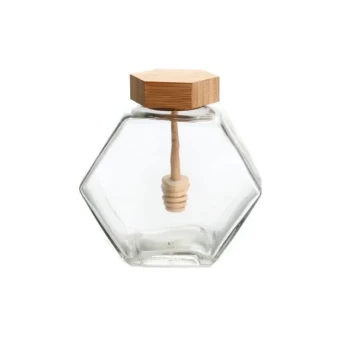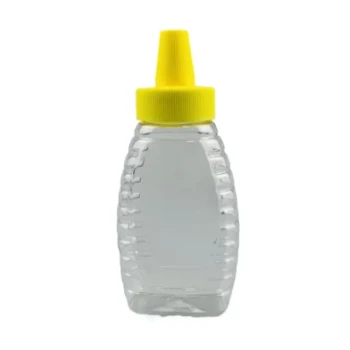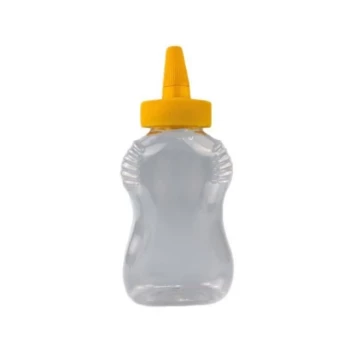To preserve its unique texture and flavor, raw honeycomb should be stored at room temperature in a sealed, airtight container, preferably made of glass. This simple method protects the delicate honey and wax from its primary enemies: air, moisture, and temperature fluctuations that can degrade its quality.
The core principle of honeycomb storage is to maintain its natural state. This means preventing the honey from absorbing moisture and, most importantly, avoiding the cold temperatures that cause the liquid honey to crystallize and ruin the honeycomb's delicate texture.
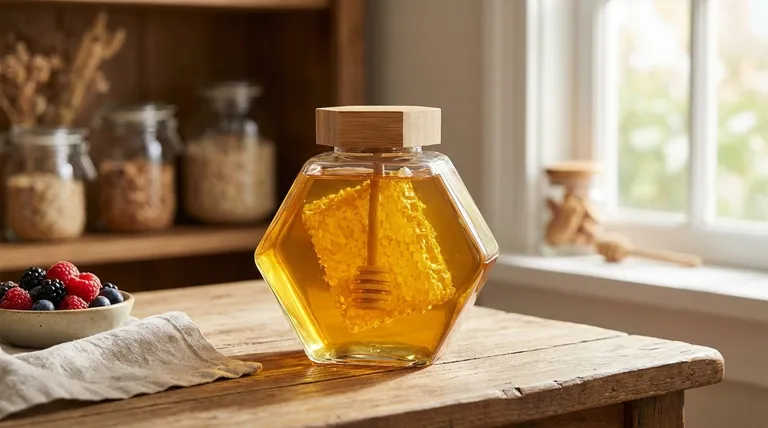
The Science of Honeycomb Preservation
Understanding why a specific storage method works is key to protecting your investment in this natural product. Honeycomb is a delicate structure of beeswax filled with raw, unprocessed honey, and its preservation depends on controlling its environment.
Why an Airtight Container is Non-Negotiable
Honey is hygroscopic, meaning it naturally absorbs moisture from the surrounding air. If left exposed, this absorbed water can increase the honey's water content to a level where dormant yeasts can activate, leading to fermentation.
Furthermore, an airtight seal prevents oxidation. Exposure to air can slowly degrade the delicate aromatic compounds in the honey, causing it to lose its unique flavor and aroma over time.
The Critical Role of Room Temperature
The most common mistake in honey storage is refrigeration. Honey is a supersaturated solution of sugars, primarily glucose and fructose. Cold temperatures encourage the glucose to separate from the water and form solid crystals.
While crystallization is a natural process in liquid honey, it is highly undesirable in honeycomb. It turns the smooth, liquid honey into a grainy, solid mass, completely altering the delightful textural contrast between the liquid honey and the chewy wax. Room temperature storage keeps the glucose dissolved and the honey fluid.
Why Glass is the Preferred Material
While any airtight container is better than none, glass is the ideal choice. Glass is non-porous and non-reactive, meaning it will not absorb odors or leach any chemicals into the honeycomb. Some plastics, on the other hand, can impart an undesirable taste over time.
Understanding the Pitfalls: Common Storage Mistakes
Many well-intentioned storage habits can inadvertently ruin honeycomb. Knowing what to avoid is as important as knowing what to do.
The Refrigerator Trap
The instinct to refrigerate food to keep it "fresh" is counterproductive for honeycomb. The refrigerator provides the exact cold, stable environment that dramatically accelerates crystallization. Storing honeycomb in the fridge is the fastest way to solidify the honey and ruin its texture.
The Freezer Exception
While refrigeration is harmful, freezing is a viable option for very long-term storage (a year or more). The extreme cold of a freezer stops molecular movement so quickly that sugar crystals do not have a chance to form.
To freeze honeycomb, wrap it tightly in multiple layers of plastic wrap and then place it in an airtight container or freezer bag. To use it, let it thaw slowly and completely at room temperature before unwrapping to prevent condensation from forming on the surface.
The Risk of Open-Air Storage
Leaving honeycomb uncovered on a counter or in a pantry is a mistake. Beyond attracting ants and other pests, it leaves the honeycomb completely vulnerable to absorbing ambient moisture and odors from your kitchen, permanently altering its flavor.
Making the Right Choice for Your Goal
Your storage method should match how long you plan to keep the honeycomb.
- If your primary focus is short-term enjoyment (up to a few months): Store it in an airtight glass jar in a pantry or cupboard away from direct sunlight and heat.
- If your primary focus is long-term preservation (6+ months): Wrap it tightly for the freezer, and thaw it slowly at room temperature when you are ready to enjoy it.
- If your honeycomb has already crystallized: You can gently warm the container in a bowl of warm (not hot) water to re-liquefy the honey crystals.
By controlling its environment, you can ensure your honeycomb remains a pristine and delicious treat.
Summary Table:
| Storage Goal | Best Method | Key Consideration |
|---|---|---|
| Short-Term (Few Months) | Airtight glass jar in a pantry | Prevents moisture absorption and flavor loss. |
| Long-Term (6+ Months) | Tightly wrapped in the freezer | Freezing prevents crystallization for extended periods. |
| If Crystallized | Gentle warming in warm water | Re-liquefies honey without damaging the comb. |
Protect your honey harvest and ensure premium quality for your customers. Proper storage is essential for commercial beekeepers and distributors to maintain product integrity. HONESTBEE supplies the durable, high-quality beekeeping supplies and equipment you need for every stage of the process, from harvest to storage. Contact our experts today to discuss wholesale solutions for your apiary or distribution business.
Visual Guide
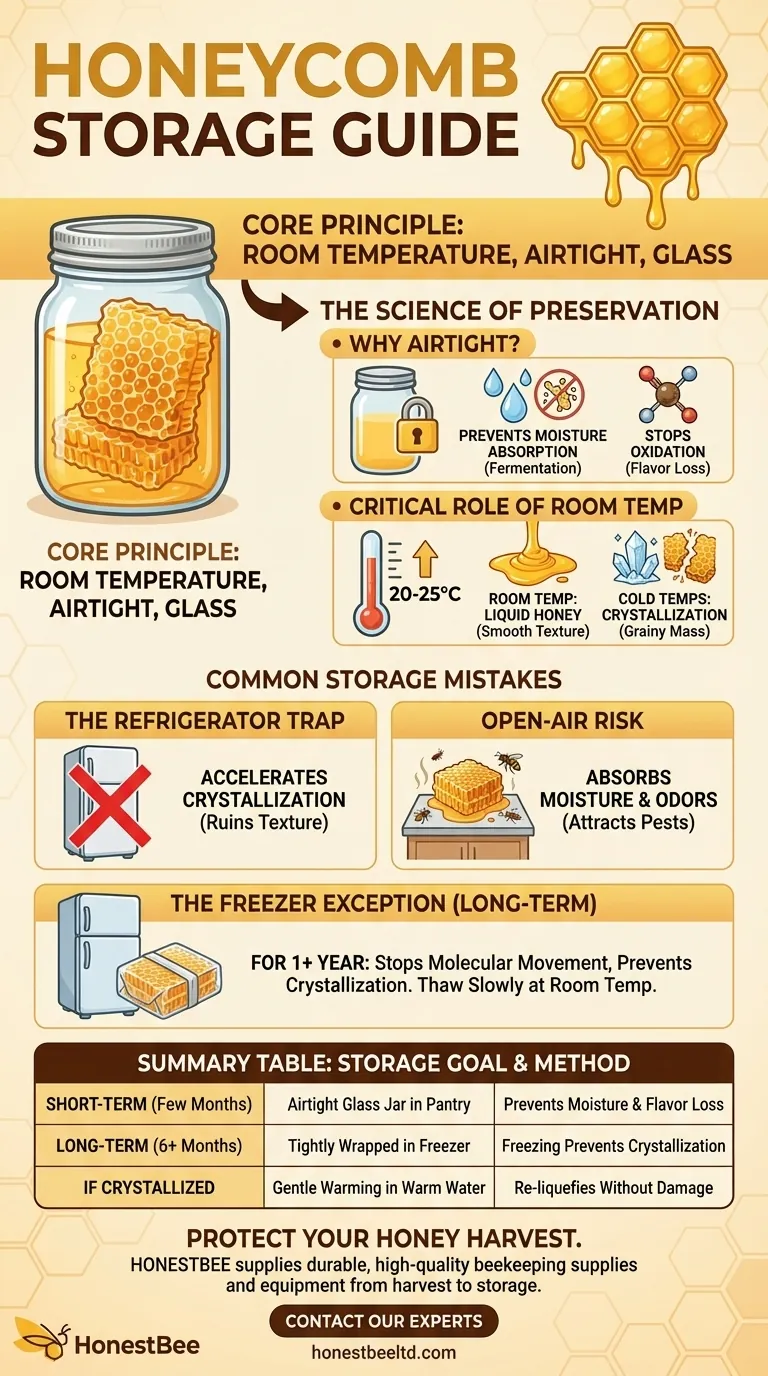
Related Products
- Hexagonal Glass Honey Jar with Wooden Lid Integrated Dipper Elegant Functional Storage
- Classic Drum Shaped Glass Honey Jar with Airtight Lid
- Hexagonal Glass Honey Jars with Metal Lug Caps Elegant Versatile Packaging
- Inverted Squeezable Honey Jar with No Drip Flip Top Cap for Easy Pouring
- Classic Beehive Honey Bottle Jar with Squeeze Dispenser Lid
People Also Ask
- What are the advantages of glass containers for honey packaging? Ensure Purity and Elevate Your Brand
- What types of containers are recommended for storing honey? Preserve Quality with the Right Materials
- Can you store honey in a plastic bucket? Yes, with the right food-grade HDPE.
- What is the best container to store honey in? Preserve Purity & Flavor for Years
- How long can you store honey in a 5 gallon bucket? Preserve Quality & Safety for Decades
